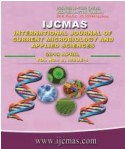


 National Academy of Agricultural Sciences (NAAS)
National Academy of Agricultural Sciences (NAAS)

|
PRINT ISSN : 2319-7692
Online ISSN : 2319-7706 Issues : 12 per year Publisher : Excellent Publishers Email : editorijcmas@gmail.com / submit@ijcmas.com Editor-in-chief: Dr.M.Prakash Index Copernicus ICV 2018: 95.39 NAAS RATING 2020: 5.38 |
The present study in sesame was undertaken to make an assessment of the combined effects of hybridization and ethyl methanesulfonate (EMS) on parameters like frequency distribution, skewness and kurtosis of quantitative traits related to productivity in F1M1 generation. Total nine populations (three EMS treated population (F11M1), their respective controls (F1s) and three varieties) were grown in a randomized block design (RBD) with three replications during summer, 2017. Observations were taken on traits, viz., plant height, number of primary branches per plant, number of capsules per plant and single plant yield. Population 1F11M1 (mutant population of Nirmala X Prachi) and 3F11M1 (mutant population of Prachi X Amrit) showed slightly negative spread and flat distribution. Frequency curves showed more or less restricted distribution in mutant population for primary branches per plant than their respective controls. In frequency curves mutant population showed slight greater spread than their respective controls for number of capsules per plant. All the three F11M1s gave a slight positive skewness for number of capsules per plant. Population 1F11M1 was found to be platykurtic. The distribution of seed yield per plant appeared to be positive skewness, longer tail to the right in all the F11M1s this is also apparent from the frequency curves. The changes in mutant populations compared to the respective controls for different characters must have come through induced micro mutations. However, these changes would be better known from analyses in later generations.
 |
 |
 |
 |
 |